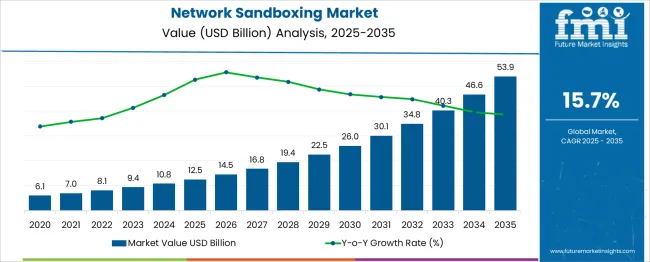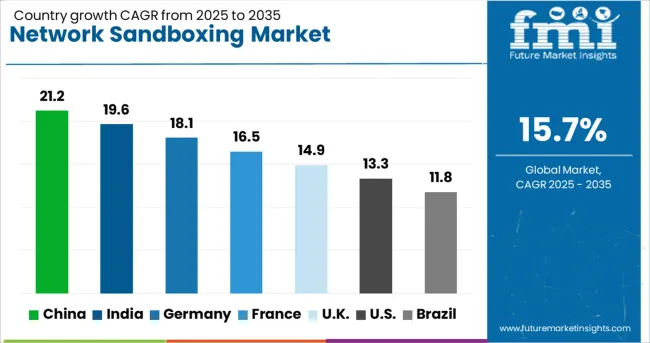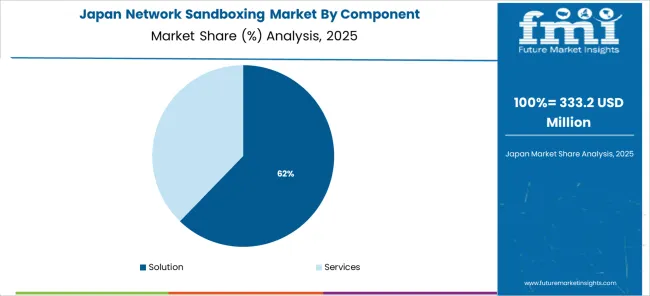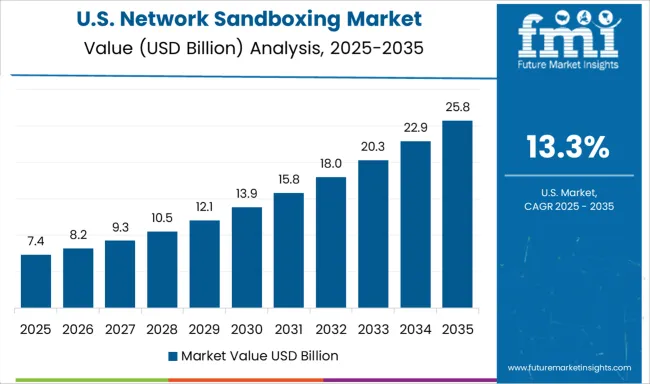The Network Sandboxing Market is estimated to be valued at USD 12.5 billion in 2025 and is projected to reach USD 53.9 billion by 2035, registering a compound annual growth rate (CAGR) of 15.7% over the forecast period.

| Metric | Value |
|---|---|
| Network Sandboxing Market Estimated Value in (2025 E) | USD 12.5 billion |
| Network Sandboxing Market Forecast Value in (2035 F) | USD 53.9 billion |
| Forecast CAGR (2025 to 2035) | 15.7% |
The network sandboxing market is estimated to rise at a 15.7% CAGR between 2025 and 2035 in comparison with 13.4% CAGR registered during 2020 to 2024. This attributes to growing adoption of advanced threat protection and sandbox security among large as well as small and mid-sized enterprises (SMEs) across the globe.
North America is expected to dominate the global network sandboxing market, reaching USD 53.9 Million by 2035. As per Forgerock, in 2020, approximately 2.8 Billion customers’ data was exposed by hackers, valuing around USD 654 Million.
Network security sandbox is a technique used for detecting targeted and malware attacks. It analyzes malware severity ratings and probability scores by monitoring network traffic for suspicious elements.
Rising adoption of advanced technologies such as Internet of Things (IoT) and Artificial Intelligence (AI) among various enterprises leads to generating large amounts of traffic/data. In recent years, the growth of the Internet of things (IoT) has contributed to advancements in smart cities, fog computing, and industry 4.0.
Adoption of IoT and AI enables the execution of complex data processing which has critical and confidential information and must be protected from cyber-attacks.
Sandboxing provides an additional layer of defense against unknown attack vectors. It improves security by integrating with existing products such as the next generation firewall, a secure subway, and unified threat management platforms. Hence, rising adoption of IoT and AI across various industries will propel the demand for network sandboxing solutions.
Most enterprises need advanced security procedures and techniques to protect applications, IT infrastructure, critical data base, and business-sensitive information. However, hackers and cybercriminals across the globe are developing advanced practices to breach the critical data of enterprises. They use multistage and multi-vector attack strategies to hack the organization’s network.
Hackers have developed cyber-attacks such as DoS and DDoS attacks, man-in-the-middle (MITM) attacks, phishing attacks, ransomware, and SQL injection attacks. Therefore, a growing need for advanced security solutions to protect from high level sophisticated cyber-attacks is expected to fuel the demand for network sandboxing solutions.


Rising Adoption of Network Sandboxing Services in Japan Will Boost Growth
Japan is anticipated to dominate the East Asia networking sandboxing market, with sales growing at a 20.9% CAGR over the forecast period. The Japan market is anticipated to create an absolute dollar opportunity of USD 12.5 Billion during 2025 to 2035.
According to Japan’s Ministry of Economy, Trade and Industry (METI), Japan faces shortages of 220,000 IT professionals in 2020 and expected to increase to 360,000 by 2025. As a result, the adoption of network sandboxing solutions has increased across various SMEs and large enterprises in the country. Therefore, rising cyber-threat is expected to drive the demand for sandbox-based gateway appliances.
Growing Awareness Regarding Network Sandboxing in India Will Fuel Demand
Sales in India are projected to increase at a 19.4% CAGR, accounting for a dominant share in the South Asia network sandboxing market over the forecast period. India is anticipated to create an absolute dollar opportunity of USD 1.7 Billion over the assessment period.
In India, the demand for network sandboxing solutions has been increasing due to the growing adoption of cybersecurity solutions by various enterprises as well as government agencies in the country. Due to regulations and stringent security compliance, government initiatives and support towards the adoption of new technology, sales of virtual sandboxing solutions will continue gaining traction over the forecast period.

High Incidence of Cyber Attacks in the USA Will Propel Networking Sandboxing Sales
Demand in the USA is projected to increase at a 11.5% CAGR over the assessment period, with total valuation reaching USD 2.2 Billion in 2025.
The USA is a developed economy that focuses on innovations obtained from security technologies and research and development (R&D). The presence of key network sandboxing solutions and service providers including Check Point Software Technologies, Cisco Systems, FireEye, Fortinet, Juniper Networks, and Palo Alto Networks is expected to bode well for the market in the forthcoming years.
Demand for Network Sandboxing Solutions Will Gain Momentum
Based on components, the solutions segment will grow by 4x during the forecast period. Network sandboxing solutions help to prevent operating systems and host devices from being exposed to potential threats.
Sandboxing is a cybersecurity technique that is used to detect suspicious cyber threats to the host machine or network, possibly from untrusted or unverified third parties, users or websites, suppliers, without causing harm to the operating system or host machine. Thus, adoption of network sandboxing solutions will increase in the forthcoming years.
Adoption of Network Sandboxing in Large Enterprises is Rising
Based on enterprise size, the large enterprise segment will expand by 3.8X during 2025 to 2035. In recent years, sandbox-based gateway security appliances have been adopted in large enterprises as well as SMEs.
Such appliances utilize a variety of tools to block unknown, new malware with targeted attacks found in downloaded files and email attachments. Sandbox-based gateway security appliances are easy to implement. Therefore, the demand for network sandboxing solutions in large enterprises is increasing during the forecast period.
Sales of Network Sandboxing Across Government Organizations Will Remain High
Based on vertical, the government and defense segment will expand by 3.2x over the forecast period. The government and defense sector is one of the main targets for cyber-attackers. Government and defense agencies need to handle sensitive and critical information. The sophistication in cyber-attacks has increased security breaches in various defense and government agencies across the globe.
Key players in the network sandboxing market are investing heavily in innovation, research, and development practices to offer different solution for various industry applications. For improving global presence, players are also investing in mergers, acquisitions, and collaborations. For instance:
| Attribute | Details |
|---|---|
| Forecast Period | 2025 to 2035 |
| Historical Data Available for | 2020 to 2024 |
| Market Analysis | USD Billion for Value |
| Key Regions Covered | North America; Latin America; Europe; East Asia; South Asia & Pacific; and the Middle East & Africa |
| Key Countries Covered | The USA, Canada, Germany, the UK, France, Italy, Spain, BENELUX, Russia, China, Japan, South Korea, India, Malaysia, Indonesia, Singapore, Australia & New Zealand, GCC Countries, Turkey, and South Africa |
| Key Segments Covered | Component, Enterprise Size, Vertical, and Region |
| Key Companies Profiled | Check Point Software Technologies; Cisco Systems; Fortinet; FireEye; Microsoft; Juniper Networks; Palo Alto Networks; Sophos; Symantec Corporation (Broadcom); Forcepoint; McAfee; SonicWall; Zscaler; Crowdstrike; Lastline; ContentKeeper Web Filter Pro |
| Report Coverage | Market Forecast, Company Share Analysis, Competition Intelligence, DROT Analysis, Market Dynamics and Challenges, and Strategic Growth Initiatives |
The global network sandboxing market is estimated to be valued at USD 12.5 billion in 2025.
The market size for the network sandboxing market is projected to reach USD 53.9 billion by 2035.
The network sandboxing market is expected to grow at a 15.7% CAGR between 2025 and 2035.
The key product types in network sandboxing market are solution, _standalone network sandbox, _integrated network sandbox, services, _professional services and _managed services.
In terms of enterprise size, small & mid-sized enterprises (smes) segment to command 61.8% share in the network sandboxing market in 2025.






Full Research Suite comprises of:
Market outlook & trends analysis
Interviews & case studies
Strategic recommendations
Vendor profiles & capabilities analysis
5-year forecasts
8 regions and 60+ country-level data splits
Market segment data splits
12 months of continuous data updates
DELIVERED AS:
PDF EXCEL ONLINE
Network Simulator Software Market Size and Share Forecast Outlook 2025 to 2035
Network Connectivity Tester Market Size and Share Forecast Outlook 2025 to 2035
Network Analyzers Market Size and Share Forecast Outlook 2025 to 2035
Network as a Service (NaaS) Market Size and Share Forecast Outlook 2025 to 2035
Network Analytics Market Size and Share Forecast Outlook 2025 to 2035
Network Devices Market Size and Share Forecast Outlook 2025 to 2035
Network Access Control (NAC) Market Size and Share Forecast Outlook 2025 to 2035
Network Monitoring Market Size and Share Forecast Outlook 2025 to 2035
Network Encryption Market Size and Share Forecast Outlook 2025 to 2035
Network Packet Broker Market Size and Share Forecast Outlook 2025 to 2035
Network Traffic Analytics Market Size and Share Forecast Outlook 2025 to 2035
Network Function Virtualization (NFV) Market Size and Share Forecast Outlook 2025 to 2035
Network Cable Tester Market Size and Share Forecast Outlook 2025 to 2035
Network Point-of-Care Glucose Testing Market Size and Share Forecast Outlook 2025 to 2035
Network Forensics Market Size and Share Forecast Outlook 2025 to 2035
Network Telemetry Market Size and Share Forecast Outlook 2025 to 2035
Network Security Policy Management Market Size and Share Forecast Outlook 2025 to 2035
Network Probe Market Size and Share Forecast Outlook 2025 to 2035
Network Traffic Analysis Solutions Market Size and Share Forecast Outlook 2025 to 2035
Network Slicing Market Size and Share Forecast Outlook 2025 to 2035

Thank you!
You will receive an email from our Business Development Manager. Please be sure to check your SPAM/JUNK folder too.
Chat With
MaRIA